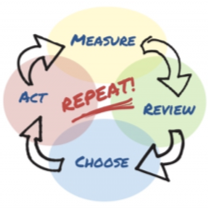Driving performance: what really works?
Summary
- What happened when the people charged with driving performance at ten great organisations came together to talk about what really works?
- Well, despite very different sectors, business models and stages of evolution, we were struck by the common challenges. We were also privileged to hear some great insights and practical tips about moving businesses along the performance development journey. This article lets you listen in on the roundtable discussion.
Focus on what shareholders hold the board accountable for
Tim Jones from London Stock Exchange Group (LSEG) explained the importance of aligning an organisation’s performance and targets to a Board’s strategy, to ensure the vision and direction was cascaded to and understood at all levels.
He discussed some recent research by Deloitte, which looked at the reward and performance measures in place for Boards across the FTSE 100. Clear financial performance metrics and an increasing number of non-financial measures, such as corporate responsibility and safety, were used to drive organisational performance.
Through extracts from the HSBC and M&S annual reports, he discussed how transparent organisations were becoming, as they looked to drive performance while delivering results to meet shareholder expectations.
At a glance – what really works?
1. Taking a shareholder perspective
2. Driving alignment – up and down
3. Measuring the right things
4. Syncing with business cycles
5. Building skills
6. Feedback loops
7. Broad reward
8. Getting started somewhere
9. Focusing on the middle
10. Strengthening relationships and networks
“Align your measures to interactions between the board and shareholders.”
Drive alignment top down and bottom up
 Tim discussed how at LSEG, one of the world’s leading exchange groups, they had used the Board’s overall direction and worked closely with the top team to really understand what it meant in terms of performance, so they could translate it into performance metrics for their key divisions.
Tim discussed how at LSEG, one of the world’s leading exchange groups, they had used the Board’s overall direction and worked closely with the top team to really understand what it meant in terms of performance, so they could translate it into performance metrics for their key divisions.
Tim’s practical advice is to balance short-term metrics like profit with long-term strategic objectives in your appraisal process, and to craft those long-term objectives very carefully. They need to be fundamental to the future success of the business, specific enough that they really mean something and have sufficient scope for everyone in the business to connect them to their day job. An example from LSEG is a key strategic pillar of “Getting in Shape”, which applies equally well at the function level and to individuals delivering efficiency and effectiveness in their own roles.
Timing is crucial, making sure your business planning, performance management and reward cycles are synchronized…”
Tim explained how he had used a programme of Performance Management Skills Labs, through which facilitated groups of managers translated these strategic objectives into specific performance objectives for their areas and teams. This created a two way channel for top down alignment and bottom up fine-tuning, with managers looking at how to make the strategy happen and senior leaders forming a clear view of how achievable each aspect of the strategy is. Tim said, “Timing is crucial, making sure your business planning, performance management and reward cycles are synchronized, and then using focused techniques like skills labs to develop skills just when people need them.”
Measure the right things

Measure the things you really want to drive
Quality of data is crucial, as is going directly for the targets you want to drive. If your strategy is all about customer service, find fast, accurate and targeted ways to measure this. Andrew Wood from Aegis Media noted that exclusive focus on process at this stage is counter-productive: “People feel boxed in and strangled. You need to get ownership for your scorecard and the way you measure things.”
Clare Hannah from DB Schenker agreed that you only really want to be put in a box once in your life! Cara Chambers from RSM Tenon highlighted the tension between holding underperformers to account and not “squashing the flair” of those who are performing well.
Bindu Sudra from KPMG, where there are many quite sophisticated tools and processes, pointed to the importance of simplicity – cutting back process to a minimum, to focus sharply on high-quality performance conversations. The message around the table was loud and clear. First, understand what good looks like, then find robust, transparent and practical ways to hold people accountable for those metrics.
Build skills
The group agreed that performance management skills are vital and often lacking. “We’re so often dealing with very bright and successful professionals who can’t manage people.”
The cost base is lean and people are time poor, so how do we teach bright people the fundamentals and motivate them to use these skills to drive performance? LSEG has used a programme of Skills Labs, which are short, sharp and punchy in-time sessions, delivered through the year to coincide with the performance calendar, so that learning is swiftly applied and embedded.
“Skills Labs are powerful because they are experiential and real”
This approach is powerful because the sessions are experiential and real – managers come to work up their own team’s objectives and prepare for real life experiences. Using inputs that are simple, informative and LSEG specific, they highlight best practice and make it easy for the manager to use, with top tips and tactics.
The Skills Lab approach encourages participants to pick up and use new techniques and approaches, and to use the power of the group to discover how best to do this in real life. High degrees of feedback, challenge and support are core to this approach, which participants find enlightening and motivating. A practical sign of its effectiveness is completion of performance reviews. Previously HR had chased these for a couple of months, but after year one of Skills Labs it took just two weeks.
The feedback loop
So you have simple, aligned and targeted performance processes, and your people possess the skills and desire to use them. What is the fuel that drives individuals and organisations towards better performance? Jenny Broughton from Ipsos hit the nail on the head here – it’s feedback. Opening and enabling feedback loops is at the core of driving performance, for individuals, teams and organisations.
 Bindu highlighted KPMG’s focus on regular conversations about performance, not just once or twice a year. Frequent and direct conversations about what’s working and what’s not, in the context of clear goals and expectations, are the nuts and bolts of a high-performance business. Whether this is happening is a great litmus test for how effectively your organisation is driving performance.
Bindu highlighted KPMG’s focus on regular conversations about performance, not just once or twice a year. Frequent and direct conversations about what’s working and what’s not, in the context of clear goals and expectations, are the nuts and bolts of a high-performance business. Whether this is happening is a great litmus test for how effectively your organisation is driving performance.
Reward is broad
During the discussion, there was consensus that there is a key link between performance and pay but that the definition of reward needs to be broader than just money. Tough economic conditions mean managers can feel they have less to offer in terms of promotion, pay rises and bonuses, so they avoid situations where people might ask for them. Helping managers think more broadly about what their team might value can make them feel better equipped for these conversations, and be more creative in their solutions.
Smart performance management initiatives tap into these elements to drive engagement and unlock discretionary effort, particularly in Generation X & Y populations.
Broad Rewards ideas:
- Flexible benefits – like bring your own phone and laptop.
- Improving the physical work environment – informal areas, better design, table footie.
- Networks – peer coaching, two way mentoring, and hook-ups between organisations like KPMG and Linklaters, where peers can broaden their experience.
- Out-of-the-box assignments and high profile or CSR related projects, for example, KPMG’s work with the Bishop of London.
- Opportunities for self development, such as talent and leadership programmes, although these may drive retention more directly than performance.
- A sense of progression, such as DB Schenker’s career paths and leadership experiences.
- Enabling people to use their talents – vertical job loading; at LSEG one of their technical platforms was developed by a 23 year old with a personal interest, on his commute.
Get started somewhere
Everyone around the table described themselves as being on a journey towards stronger performance, and we talked about how to get the organisation in motion. Modelling from the top is vital: “If your top team doesn’t manage its own performance, and you can’t recognise them from your competency model, it’s going to be a tough slog.”
Even when support from the top is strong and credible, building sufficient consensus to launch performance management initiatives can be hard. Cara Chambers advocates not letting the perfect get in the way of the achievable. Models, frameworks, approaches and processes need to be good enough. Then you can refine them as you use them, rather than let them gather dust as you seek to perfect them for stakeholders with disparate needs. Just get started, and you’ll find that, “pockets of high-impact development will spread.”
“Pockets of high-impact development will spread.”
Going one step further, Alan Arnett from XL Group described his “guerrilla approach” to performance development – seizing opportunities to coach and train people and teams in performance development as live business issues arise, to help people apply the principles in difficult situations.
Another arch pragmatist, Joanne Maruri from JLT Group, recommended delivering some quick practical wins in terms of making processes work better. These boost morale and open the door to more sophisticated interventions.
Focus on the middle
Most organisations around the table focused on helping first-time managers and emerging leaders understand what good management looks like and enabling senior leaders to drive the performance agenda from the top. It was intriguing, then, that there was also consensus that middle management is the most important and intractable group. It’s here that alignment often falters and sometimes fails.
The current climate exacerbates this, with people spending longer at this level, often with frozen pay and little prospect of promotion. The group agreed that finding ways to engage, motivate and up-skill this layer is critical to day-to-day organisational efficiency, and delivering strategic change over the longer term. At this career stage, people have often developed a specialism or a unique way of contributing. Jane Tribaudi from Parabis reminded us that recognising and rewarding this individuality, with a system that works for “peacocks and penguins”, is vital to engagement.
“A system that works for “peacocks and penguins” is vital to engagement.”
Where’s it going?
We were also convinced that the future of performance management is moving away from framework and processes, towards relationships and networks. Connecting cohorts across functions, silos and even organisations, and using real-world challenges to expose, stretch and activate people, is the next holy grail of driving performance. Delivering against this new agenda means finding more dynamic ways to manage performance and tapping into new ways of connecting, engaging, aligning and mobilising people.
With thanks to our Driving Performance Group:
Tim Jones – London Stock Exchange Group
Alan Arnett – XL Group
Andrew Wood – Aegis Media
Bindu Sudra – KPMG
Cara Chambers – RSM Tenon
Clare Hannah – DB Schenker
Jane Tribaudi – Parabis
Jennifer Baker – JLT Group
Jenny Broughton – Ipsos
Joanne Maruri – JLT Group
For more information please contact: Mike Vessey

